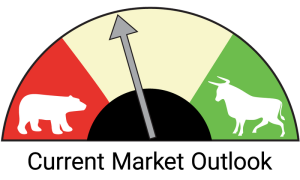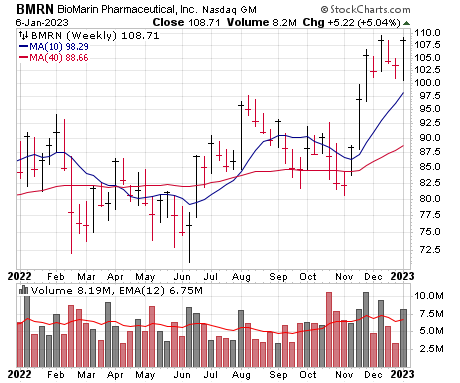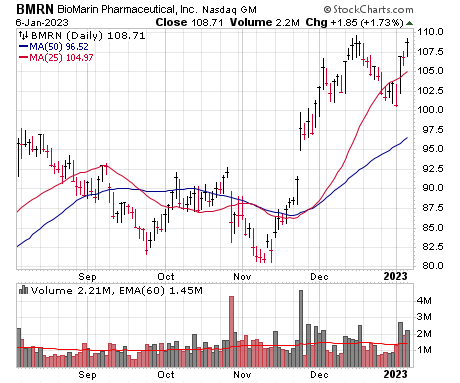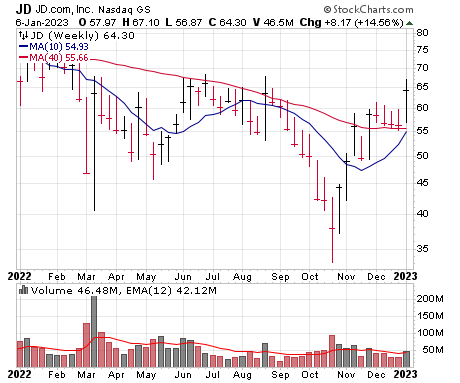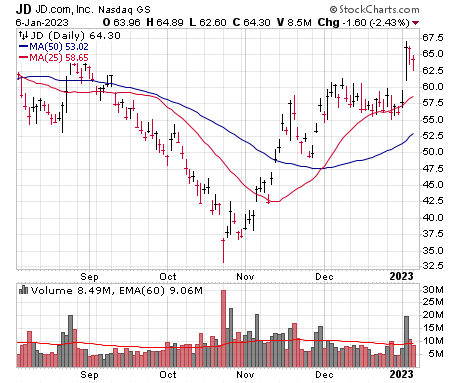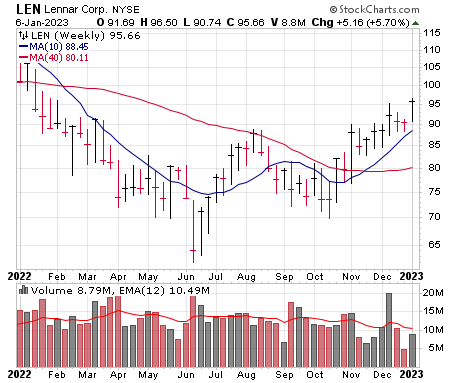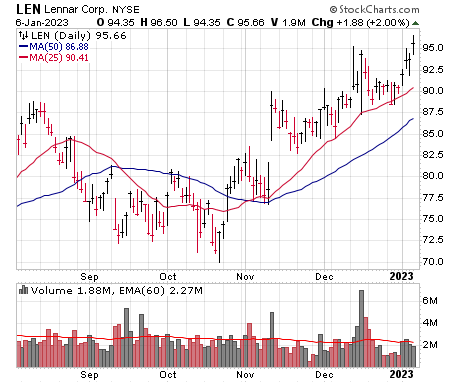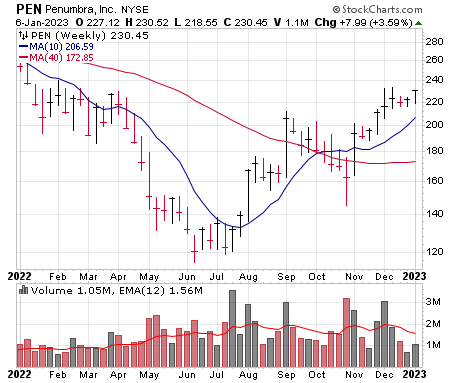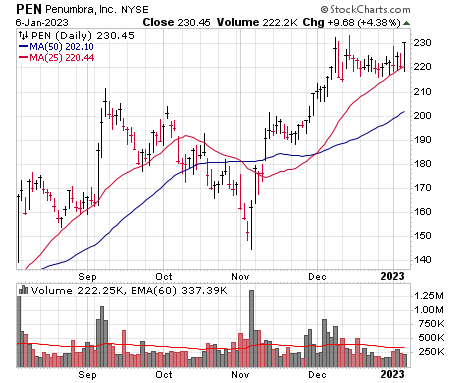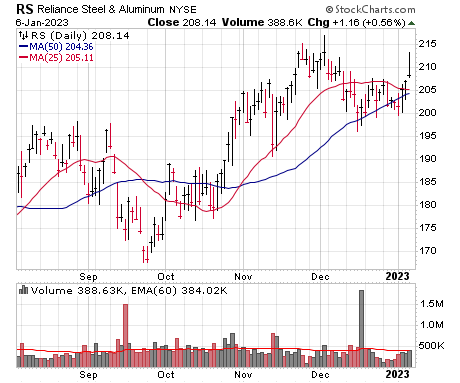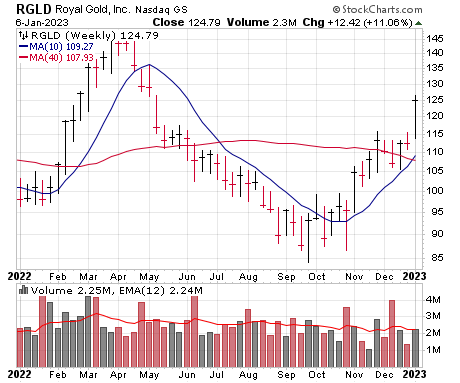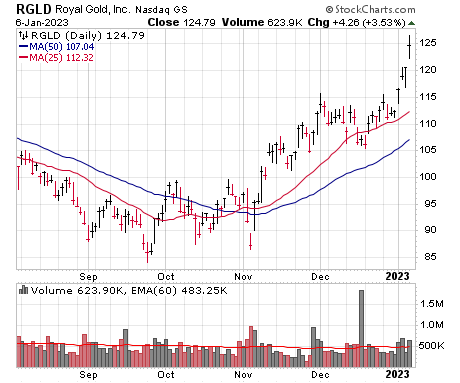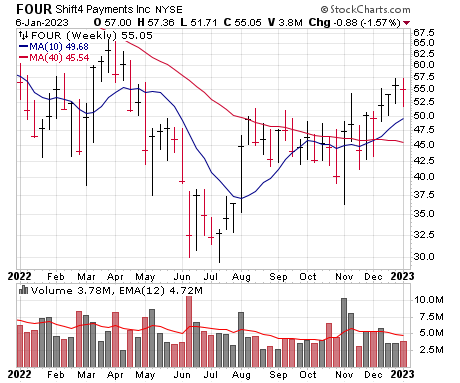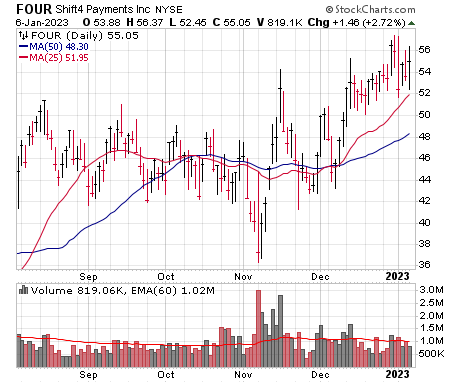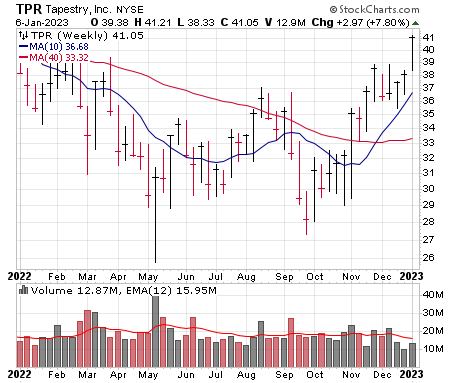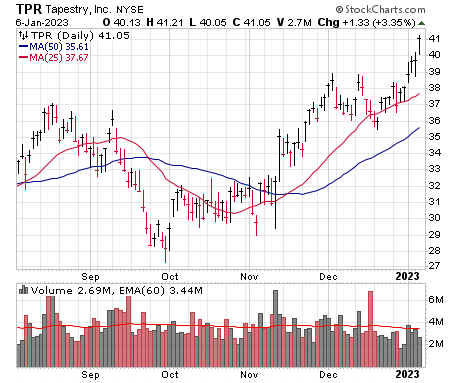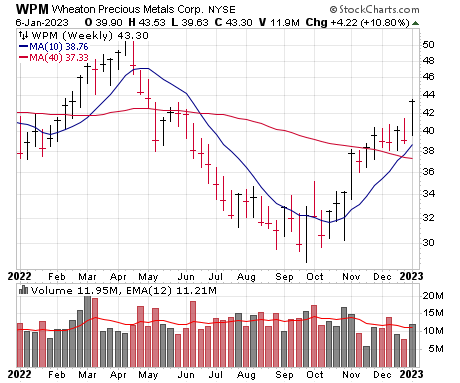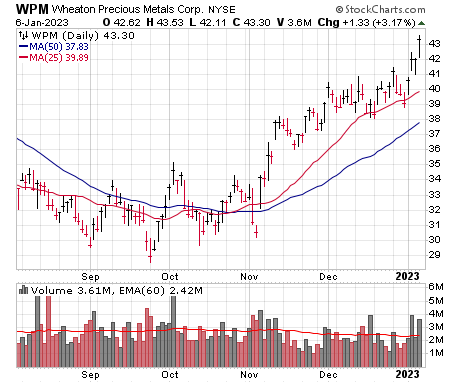Broad Market Improving
It was a solid week for the major indexes, most of which finished up decently (1% to 2.5%) to start 2023, and even better has been some notable improvement in the broad market—in late December, we saw a key positive divergence from a broad market measure for the Nasdaq, and now we’re starting to see some legit improvement elsewhere, too. Don’t get us wrong, at this point, the major trends are still pointed sideways-to-down and defensive stocks are still (mostly) leading the way, so we’re not going to make too much out of what we see, especially as early January is often filled with crosscurrents. But it’s fair to say we’re approaching another key juncture: If the market and (importantly) individual stocks are able to build on their recent action, we could get a green light or two and have something to work with—but as has been the case for months, we want to see it happen first before extending our line in any major way. For now, our Market Monitor remains a level 4, but our antennae are up as we watch to see if the sellers really have left the building.
This week’s list is another hodgepodge, with some commodity and value names combined with a few turnaround and growth titles. Our Top Pick is Penumbra (PEN), a solid long-term grower that has some catalysts for this year—as usual, aim to enter on dips.
| Price |
Stock 1
Berry Global (BERY)
Price | Buy Range | Loss Limit |
Why the Strength
It’s not the sexiest industry, but plastics represent one of the largest manufacturing spaces in the U.S., with products that are always in demand. Berry Global is a leader in the space and makes non-woven, flexible and rigid products used mainly for packaging. Its three core divisions—Consumer Packaging, Engineered Materials and Health, Hygiene and Specialties—serve virtually every major industry worldwide, with the firm counting over 2,500 clients, including McDonald’s, Procter & Gamble, Coca-Cola and Walmart. Business has been booming for Berry, as shown by the company’s recent initiation of its first ever quarterly dividend (1.6% annual yield). Berry has also been returning excess capital to shareholders through share repurchases, with the current authorization around $1 billion (13% of the market cap), thanks in part to healthy free cash flows. Indeed, the company ended its fiscal 2022 in November with record free cash flow of $876 million for the full year (north of $7 per share)—17% above prior guidance—and returned a whopping $709 million to shareholders via share repurchases during the year. While Q4 revenue was 7% lower from a year ago, it reached a record level for the full year (up 10%), while earnings continued to kite higher ($2.19 per share, up 16% in the quarter). In the last six years, Berry has been able to increase its sales by an industry-topping 14% annually, mainly due to acquisitions, and on that front, the firm is focused on fast-growing markets and geographies (including India), particularly in the pharma and healthcare spaces. Management expects EPS to grow about 8% and for free cash flow to again be in the $7 per share range for the current fiscal year. It’s not changing the world, but Berry is a well managed, consistent grower.
Technical Analysis
BERY hit a record peak at 75 at the start of last year but dropped to 53 by early March, chopped sideways for a few months and then sunk to its nadir in September in the mid-40s. The next month-plus served as a bottoming area, and then the buyers arrived, pushing shares back above the 60 area (and above its 40-week line)—and BERY has held firm since, holding its 25-day line while consolidating its rally. We’re OK taking a stab at it here or (preferably) on dips if you want in.
| Market Cap | $2.56B | EPS $ Annual (Sep) | ||
| Market Cap | $7.63B | FY 2021 | 7.21 | |
| Forward P/E | 8 | FY 2022 | 7.40 | |
| Current P/E | 8 | FY 2023e | 7.51 | |
| Annual Revenue | $14.5B | FY 2024e | 8.26 | |
| Qtrly Rev | Qtrly Rev Growth | Qtrly EPS | Qtrly EPS Growth | |
| ($B) | (vs. yr-ago-qtr) | ($) | (vs. yr-ago-qtr) | |
| Latest qtr | 3.42 | -7% | 2.19 | 16% |
| One qtr ago | 3.73 | 1% | 2.03 | 10% |
| Two qtrs ago | 3.78 | 12% | 1.93 | -2% |
| Three qtrs ago | 3.57 | 14% | 1.25 | -16% |
Weekly Chart | Daily Chart |
Stock 2
BioMarin Pharmaceutical (BMRN)
Price | Buy Range | Loss Limit |
Why the Strength
BioMarin Pharmaceuticals looks like one of the leaders in the medical and biotech sector, with a combination of a healthy current business that has solid growth potential—but also a couple of high-potential drugs that look set to significantly boost results going ahead. The company has seven drugs on the market that target rare conditions, and while a couple are past their peak, a handful are seeing solid growth (up 5% to 15%) this year, which is keeping the bottom line solidly in the black. That said, the real excitement concerns two particular offerings, the first being Voxzogo, which got a thumbs up from the FDA a year ago for a specific type of short-limbed dwarfism; one analyst sees peak sales for the drug at north of $1 billion down the road, and it’s off to a good start ($48 million of revenue in Q3, with a Japan launch just occurring in August). Then there’s Roctavian, a gene therapy for hemophilia A, which actually has a spotty past (rejected by the FDA two years ago), but now the agency looks to be on board—most believe the FDA will likely approve it officially in Q1, and Europe already gave the go-ahead in the third quarter of last year. At $2 million per treatment, it could be a difference maker. Growth has been solid of late, with sales accelerating in Q3, and non-GAAP earnings up 26% in the first nine months of the year—and analysts see sales cranking ahead nicely this year (low/mid 20% range) while earnings continue to ramp. It’s not cheap but the growth story is a good one.
Technical Analysis
BMRN was basically rangebound for a couple of years following the FDA’s rejection of Roctavian in late 2020, with the mid-90s proving to be tough to overcome despite a few breakout attempts (including one in early August that failed due to the market). But after another retrenchment, BMRN is off and running, with upside power being shown in November on positive FDA vibes, and shares have acted well since, including last week’s solid-volume rally. Some medical names saw selling today, but this one looks fine—further dips should be buyable.
| Market Cap | $19.7B | EPS $ Annual (Dec) | ||
| Forward P/E | 52 | FY 2020 | 1.63 | |
| Current P/E | 66 | FY 2021 | 1.33 | |
| Annual Revenue | $2.01B | FY 2022e | 0.68 | |
| Profit Margin | 16.4% | FY 2023e | 2.08 | |
| Qtrly Rev | Qtrly Rev Growth | Qtrly EPS | Qtrly EPS Growth | |
| ($M) | (vs. yr-ago-qtr) | ($) | (vs. yr-ago-qtr) | |
| Latest qtr | 505 | 24% | 0.45 | 150% |
| One qtr ago | 534 | 6% | 0.58 | 9% |
| Two qtrs ago | 519 | 7% | 0.54 | -5% |
| Three qtrs ago | 450 | -1% | 0.04 | -81% |
Weekly Chart | Daily Chart |
Stock 3
JD.com (JD)
Price | Buy Range | Loss Limit |
Why the Strength
JD.com is the largest retailer in China, an e-commerce pioneer that now has some 600 million active customers. Unlike other large Internet retailers, like Alibaba and Amazon, JD holds most of the things it sells as its own inventory and has gained a reputation for selling authentic products, avoiding the bugaboo of counterfeit third-party offerings that’s relatively prevalent in China. That means in addition to all the miscellaneous, random offerings most large e-retailers sell, JD is also is able to offer premium goods like Fendi bags and Apple products in close partnership with those brands. The company bolsters its retail appeal to mainland Chinese shoppers by maintaining its own logistics network, offering last-mile delivery to nearly all of China through 1,500 warehouses and 280,000 personnel. JD benefitted from the pandemic lockdowns of the past three years as constrained consumers did more web shopping. But the end of the zero-Covid policy in China should benefit JD’s plans for 2023, which include applying its logistics expertise to helping other companies get their goods from China to the U.S. and building the business of online grocer Dada, which it purchased a majority control of last year. The retail side of JD.com is the lion’s share of sales right now – 97% of 2022’s projected $158 billion revenue. JD expects its experience with prior fresh food deliveries will make Dada a fast grower, while opening up its logistics and tech platforms for other retailers to use will reduce its dependence on hawking its own goods. Even though it’s already a large business, revenue is seen growing some 20% in 2023 with earnings per share likely to get over $3 per share, nearly double that of two years ago.
Technical Analysis
JD has followed the path of most Chinese peers, with a giant plunge into March, months of consolidation and then one final shakeout in October before the last of the weak hands were tossed aside. And now the stock’s character has changed, with a powerful off-the-bottom rally for JD and a month of tight trading—followed by last week’s modest-volume leap to five-month highs. It’s a volatile name, so we’ll set our buy range down a couple of points, thinking normal volatility will offer a better entry point.
| Market Cap | $100B | EPS $ Annual (Dec) | ||
| Forward P/E | 21 | FY 2020 | 1.51 | |
| Current P/E | 29 | FY 2021 | 1.67 | |
| Annual Revenue | $155B | FY 2022e | 2.40 | |
| Profit Margin | 4.1% | FY 2023e | 3.03 | |
| Qtrly Rev | Qtrly Rev Growth | Qtrly EPS | Qtrly EPS Growth | |
| ($B) | (vs. yr-ago-qtr) | ($) | (vs. yr-ago-qtr) | |
| Latest qtr | 34.2 | 1% | 0.88 | 80% |
| One qtr ago | 39.9 | 2% | 0.61 | 36% |
| Two qtrs ago | 37.8 | 22% | 0.40 | 5% |
| Three qtrs ago | 43.4 | 26% | 0.35 | 52% |
Weekly Chart | Daily Chart |
Stock 4
Lennar (LEN)
Price | Buy Range | Loss Limit |
Why the Strength
When it comes to the U.S. economy as a whole, just about everyone (including 98% of CEOs according to one survey) expects a recession this year, and when it comes to housing, it’s even more of a done deal—pending home sales, for instance, have declined five straight months and are down a whopping 37% from a year ago! And that’s already starting to have an impact on the leading players in the group like Lennar—while deliveries in the quarter that ended November were up 13%, the value of new orders and the value of its backlog both dipped more than 20% while cancellation rates soared. There’s little doubt the next couple of quarters will be rough, but the stock is heading higher for a few reasons: First, of course, many are thinking mortgage rates have hit their peak, dipping from north of 7% in October and holding toward 6% … with lower rates likely should the economy weaken, as most expect. Second, when it comes to Lennar, the firm has the best balance sheet in its history (lowest homebuilding debt-to-capital ratio in its history; $7.2 billion of liquidity and no maturities until next year), and with the Fed telegraphing its hawkishness last year, it’s also slashed costs. And that’s led to number three, which is that, despite the headwinds, Lennar is expected to remain super profitable (near $10 earnings per share this year; stock trades at less than 10x that figure), with management forecasting deliveries to drop just 6% in the coming year. Long story short, even if the housing market takes a big hit and stays down, Lennar’s stock has likely discounted most of it—so if something goes right, the stock should continue to do well. A 1.6% dividend doesn’t hurt the cause.
Technical Analysis
LEN’s top-to-bottom decline from late 2021 to June of last year was nearly 50% and brought the stock back to its pre-pandemic peak, discounting all sorts of mayhem. The initial rally ran into a wall at the 40-week line, but the autumn saw a much higher low (~90 vs. 75) and now LEN is pushing higher—it’s not setting the world on fire and it’s sure get pushed/pulled by economic reports and interest rate movements, but the path of least resistance is up. Dips should offer a good opportunity.
| Market Cap | $28.0B | EPS $ Annual (Nov) | ||
| Forward P/E | 10 | FY 2021 | 12.68 | |
| Current P/E | 5 | FY 2022 | 17.91 | |
| Annual Revenue | $33.7B | FY 2023e | 9.80 | |
| Profit Margin | 14.2% | FY 2024e | 10.48 | |
| Qtrly Rev | Qtrly Rev Growth | Qtrly EPS | Qtrly EPS Growth | |
| ($B) | (vs. yr-ago-qtr) | ($) | (vs. yr-ago-qtr) | |
| Latest qtr | 10.20 | 21% | 5.02 | 15% |
| One qtr ago | 8.90 | 29% | 5.18 | 58% |
| Two qtrs ago | 8.36 | 30% | 4.69 | 59% |
| Three qtrs ago | 6.20 | 16% | 2.70 | 32% |
Weekly Chart | Daily Chart |
Stock 5
Penumbra (PEN) ★ Top Pick ★
Price | Buy Range | Loss Limit |
Why the Strength
Penumbra is about to roll out a new series of tools for treating vascular blockages that should vault the business over $1 billion in annual revenues for the first time. The California-based company will roll out three products this year: Lightning Flash, Lightning Bolt and Thunderbolt, representing significant advances in the treatment of blockages in blood vessels, including deep vein thrombosis (DVT), pulmonary embolisms (PE) and the recovery of neurological vessels after strokes. Penumbra already has a fine business in those areas, having grown sales from $547 million in 2019 to what will end up around $843 million for 2022. But investors really have their eye on the years ahead since management has been touting the new products as paradigm changing. Penumbra used algorithm-aided computer modeling to develop its new products, and trials showed the offerings will be more effective for a broader range of blood vessel issues. Lightning Flash, rolling out this month, is the latest iteration of its vascular system, allowing the insertion of a very small tube into blood vessels to then use vacuum pressure to remove blockages and monitor for a recovery of blood flow. Similarly, Thunderbolt is an advanced catheter that allows for less-invasive ways to re-establish blood flow through vessels in the brain after strokes. The expectation is that the innovations coming out this year will allow doctors to dramatically reduce open surgery for vessel treatment and improve patient monitoring. For investors, it’s also expected to shift the company into a faster-growing, more profitable entity. Sales are expected to rise at least 19% this year and accelerate after that, with gross margins expanding in coming years (to 70% from about 63% recently) and with earnings beginning to lift off in 2023. Earnings are likely out in mid-February.
Technical Analysis
PEN topped out for much of 2021 and then collapsed with everything else, falling by more than 50% to its nadir in June. The summer rally was excellent but didn’t stick, with a wicked dip into early November. But the Q3 report changed everything—PEN exploded higher on giant volume after the release, hit seven-month highs in December and has tightened up just above its 25-day line for the past few weeks. We’re OK taking a nibble here or ideally on weakness should today’s rotation out of some medical names continue.
| Market Cap | $8.73B | EPS $ Annual (Dec) | ||
| Forward P/E | 227 | FY 2020 | -0.70 | |
| Current P/E | 999 | FY 2021 | 0.69 | |
| Annual Revenue | $830M | FY 2022e | 0.15 | |
| Profit Margin | 0.1% | FY 2023e | 1.01 | |
| Qtrly Rev | Qtrly Rev Growth | Qtrly EPS | Qtrly EPS Growth | |
| ($M) | (vs. yr-ago-qtr) | ($) | (vs. yr-ago-qtr) | |
| Latest qtr | 214 | 12% | 0.01 | -92% |
| One qtr ago | 208 | 13% | 0.01 | -95% |
| Two qtrs ago | 204 | 21% | -0.01 | N/A |
| Three qtrs ago | 204 | 22% | 0.10 | 150% |
Weekly Chart | Daily Chart |
Stock 6
Reliance Steel & Aluminum (RS)
Price | Buy Range | Loss Limit |
Why the Strength
A strong late-year recovery in the metals-intensive energy and aerospace sectors, as well healthy metals demand in the semiconductor industry, has boosted the outlook for producers of steel and aluminum. Reliance sells both and is the largest metals service center operator in North America, providing metals processing, inventory management and delivery service for an array of industries. China’s reopening is expected to provide a tailwind for both steel and aluminum consumption in 2023, but even without China, demand from the red-hot alternative energy sector, plus infrastructure spending, should keep helping the cause this year. In Q3, Reliance saw revenue of $4.3 billion that jumped 10% from a year ago, plus per-share earnings of $6.48 that beat estimates by 29 cents. Another highlight of the quarter was record cash flow from operations of $636 million (up 36%), which helped fuel the firm’s “solid” Q3 stockholder returns, including $390 million in dividends (1.7% annual yield) and stock repurchases (with $763 million remaining on the buyback authorization). Management anticipates that demand for nonresidential construction—the company’s largest end market—will remain stable going forward and should also benefit from the infrastructure bill. Meanwhile, the semiconductor industry remains one of Reliance’s strongest markets and remains “robust,” and the firm is making “significant” investments in this market ahead of an anticipated expansion in domestic chip fabrication. While pricing normalization is likely to drag earnings down this year, the valuation here remains compelling, with the stock trading at just 11x those lower estimates.
Technical Analysis
RS managed to buck the weakness that plagued the broad metals market through much of last year, maintaining its long-term upward trend. The stock met with strong resistance last May at 210, prompting a sell-off to the 200-day line in June and a temporary bounce higher into August. A second test of the 200-day line followed in September, but shares roared back to life the next month and RS is now about even with its peaks from last year—great relative strength. We’ll set our buy range up a bit from here, looking for a strong push higher to start a position.
| Market Cap | $12.2B | EPS $ Annual (Dec) | ||
| Forward P/E | 11 | FY 2020 | 7.71 | |
| Current P/E | 7 | FY 2021 | 22.12 | |
| Annual Revenue | $17.4B | FY 2022e | 28.82 | |
| Profit Margin | 9.3% | FY 2023e | 19.20 | |
| Qtrly Rev | Qtrly Rev Growth | Qtrly EPS | Qtrly EPS Growth | |
| ($B) | (vs. yr-ago-qtr) | ($) | (vs. yr-ago-qtr) | |
| Latest qtr | 4.25 | 10% | 6.48 | 5% |
| One qtr ago | 4.68 | 37% | 9.15 | 81% |
| Two qtrs ago | 4.49 | 58% | 8.42 | 105% |
| Three qtrs ago | 3.99 | 87% | 6.83 | 240% |
Weekly Chart | Daily Chart |
Stock 7
Royal Gold (RGLD)
Price | Buy Range | Loss Limit |
Why the Strength
Unlike most gold outfits, Royal Gold doesn’t actually engage in mining. Instead, it’s a streamer—a provider of up-front payments to miners in exchange for the right to buy gold, silver, copper and other resources at a set (low) price, or else receive a percentage of the sales of the metal when they occur. This focus on royalties gives the firm an advantage over traditional mining companies in a weak gold price environment (which was the case for much of 2022). At first glance, Royal’s Q3 report was a disappointment, as revenue of $131 million ($99 million in streaming revenue and $33 million in royalties) was 25% lower from a year ago, while per-share earnings of 71 cents missed estimates by 1 cent. But this obscured some solid tidings, including that Royal achieve the full recovery of a $782 million stream advance payment at its Mount Milligan copper/gold mine in Canada. It also announced the mine’s expected life has been extended by four years, to 2033, which means a significantly longer runway of gold and silver payouts are likely. Royal also maintained its long-term growth strategy in Q3 by adding significant assets to its royalty portfolio: In July, it announced a $150 million acquisition of Great Bear Royalties, which holds a 2% royalty over the Great Bear project—Canada’s newest major gold discovery run by Kinross Gold. (The project is considered an “emerging world class gold project with long-term growth potential” and is expected to be in production by 2027.) Moving forward, Royal said it’s on the lookout for additional opportunities to expand its mine portfolio, while remaining focused on obtaining cash flow from the best assets and cranking out huge margins (36% after-tax profit margins in Q3). Analysts, meanwhile, see sales and EPS jumping around 13% this year, which should prove conservative as gold prices rebound.
Technical Analysis
RGLD had a nice run early last year but peaked in April at 147 and embarked on a persistent decline, skidding all the way to 85 in September. But then shares bottomed out for a few weeks and took off with the entire gold group in early November—and RGLD really hasn’t stopped since, with just a brief four-week rest in December before the buyers were at it again last week. We like the action, but probably wouldn’t chase after last week’s move; look for dips of a few points if you want in.
| Market Cap | $8.19B | EPS $ Annual (Dec) | ||
| Forward P/E | 33 | FY 2020 | 2.93 | |
| Current P/E | 34 | FY 2021 | 4.01 | |
| Annual Revenue | $608B | FY 2022e | 3.34 | |
| Profit Margin | 35.8% | FY 2023e | 3.79 | |
| Qtrly Rev | Qtrly Rev Growth | Qtrly EPS | Qtrly EPS Growth | |
| ($M) | (vs. yr-ago-qtr) | ($) | (vs. yr-ago-qtr) | |
| Latest qtr | 131 | -25% | 0.71 | -34% |
| One qtr ago | 146 | -13% | 0.81 | -22% |
| Two qtrs ago | 162 | 14% | 0.99 | 18% |
| Three qtrs ago | 169 | 6% | 1.05 | 14% |
Weekly Chart | Daily Chart |
Stock 8
Shift4 Payments (FOUR)
Price | Buy Range | Loss Limit |
Why the Strength
Growth stocks continue to bring up the rear of the market for the most part (with lots of rotation and selling on strength), but Shift4 continues to look like an exception, with the stock continuing to test multi-month highs even when the market and growth stocks hit the skids. And we think there’s good reason for it: Shift4’s integrated payment solutions have had a big following for years (over 200,000 clients), starting with the restaurant and hospitality area but expanding rapidly of late to include many newer growth sectors like gambling, sports and entertainment (including stadiums; its offering is great for large areas and campuses), travel, non-profits and more, and is attractive bigger fish in the process (average merchant spending is three times the size compared to 2019). Shift4’s new cloud-based SkyTab point-of-sale system (new as of September) could be big, offering not just payment processing but front-to-back operations management for restaurant owners and free loyalty, online ordering and marketplace modules; it’s useful in many non-restaurant settings, too. Even better, though, is the potential of its new sectors, with Shift4 inking tons of seemingly big deals (biggest theme park in the U.S.; biggest casino in the world; multiple stadiums including NRG stadium in Houston; St. Jude Children’s Hospital and more than 2,000 non-profits; up and running with Allegiant Airlines as of Q4) that should goose volume going ahead. There is competition, but Shift4 is certainly gaining share, with the only worry being the economy—a big recession could crimp spending and profits, of course. But the momentum of the business looks powerful: Not only are sales, payment volume, earnings and free cash flow kiting higher, but estimates have moved up nicely during the past year (unlike most peers) and management believes revenues can rise nearly 60% during the next two years (2023 and 2024) while payment volume more than doubles. It’s a big story.
Technical Analysis
While most payment peers languish, FOUR bottomed in July and rallied nicely after earnings in August, and it held up well (albeit with a lot of hacking around) during the market’s fall plunge, with the stock “only” seeing a brief shakeout in November before snapping back. And now, while still choppy, FOUR is nosing to higher highs—the RP line hit a new peak just before year end, and FOUR continues toy with multi-month highs. Selling on strength is still the norm with most names and especially growth stocks, so we’ll set our entry point down a bit from here.
| Market Cap | $4.50B | EPS $ Annual (Dec) | ||
| Forward P/E | 27 | FY 2020 | -0.58 | |
| Current P/E | 54 | FY 2021 | 0.45 | |
| Annual Revenue | $1.86B | FY 2022e | 1.35 | |
| Profit Margin | 6.7% | FY 2023e | 2.01 | |
| Qtrly Rev | Qtrly Rev Growth | Qtrly EPS | Qtrly EPS Growth | |
| ($M) | (vs. yr-ago-qtr) | ($) | (vs. yr-ago-qtr) | |
| Latest qtr | 547 | 45% | 0.44 | 69% |
| One qtr ago | 507 | 44% | 0.33 | 43% |
| Two qtrs ago | 402 | 68% | 0.15 | N/A |
| Three qtrs ago | 399 | 89% | 0.08 | N/A |
Weekly Chart | Daily Chart |
Stock 9
Tapestry Inc. (TPR)
Price | Buy Range | Loss Limit |
Why the Strength
Apparel stocks are back in vogue as Wall Street anticipates better margins and higher profits ahead in 2023 for this sector as cost inflation (presumably) recedes. Tapestry is a New York-based luxury fashion operation which owns three major brands, including Coach, Kate Spade and Stuart Weitzman. While Covid-related headwinds have been problem a problem for one of Tapestry’s key markets, China, the company nonetheless saw record revenue of $1.5 billion (up 2% from a year ago) in the September quarter along with a 3-cent earnings beat that came in at 79 cents per share. The uplifting results were thanks in large part to noteworthy growth in Europe, where quarterly sales increased 24%, and Japan (a key market for Tapestry), where revenue rose 16%. Meanwhile, other Asia revenue (which includes Australia and New Zealand) grew an outstanding 135%. While sales in China declined 11% in the quarter, the country’s recent abandonment of its zero-Covid policy is expected to boost Tapestry’s profit outlook in the coming quarters. For that reason, several major Wall Street institutions have lately upped their ratings for the stock, with the additional expectation that Tapestry’s strong free cash flow will enable generous shareholder returns in the form of dividends and share buybacks; management plans to return as much as $1 billion—or 10% of the market cap—in 2023, including a solid 2.9% dividend. Another highlight for the company in the quarter was its gain of 1.4 million in new North American customers, which Tapestry sees driving future growth in omnichannel (store and online) spending. Wall Street sees mid-single-digit growth, which is likely conservative but could be enough to attract buyers given the tame valuation.
Technical Analysis
TPR was hit by inflation and China-related headwinds for much of the last two years, with shares nearly getting cut in half from a multi-year high of around 50 in May 2021 to their final low above 26 last May. That set the stage for a lengthy bottoming process which saw the stock establish a higher low in September, then go on to start a new uptrend beginning in October. TPR has made serious strides in the last three months and last week’s rally (albeit on tame volume) brought shares to 10-month highs. Look for a pullback to buy.
| Market Cap | $9.89B | EPS $ Annual (Jun) | ||
| Forward P/E | 10 | FY 2021 | 2.97 | |
| Current P/E | 12 | FY 2022 | 3.47 | |
| Annual Revenue | $6.71B | FY 2023e | 3.63 | |
| Profit Margin | 13.0% | FY 2024e | 4.17 | |
| Qtrly Rev | Qtrly Rev Growth | Qtrly EPS | Qtrly EPS Growth | |
| ($B) | (vs. yr-ago-qtr) | ($) | (vs. yr-ago-qtr) | |
| Latest qtr | 1.51 | 2% | 0.79 | -4% |
| One qtr ago | 1.62 | 1% | 0.78 | 5% |
| Two qtrs ago | 1.44 | 13% | 0.51 | 0% |
| Three qtrs ago | 2.14 | 27% | 1.33 | 16% |
Weekly Chart | Daily Chart |
Stock 10
Wheaton Precious Metals (WPM)
Price | Buy Range | Loss Limit |
Why the Strength
Wheaton is the second precious metals stock in Top Ten this week, but neither is a miner—instead, both are streaming plays, with Wheaton being one of the world’s largest, with agreements for 21 operating mines and 13 development stage projects to purchase all or a portion of their gold, silver or cobalt production for an upfront payment. This business strategy produces big margins and allows the company to remain relatively insulated from the rising cost inflation impacting other miners. Wheaton’s main focus is on high-quality, high-margin operations with a goal of returning a minimum of 30% of cash flow to its shareholders. As was the case for most gold firms, revenue was lower for Wheaton in Q3 (down 19% from a year ago), mainly due to lower gold and silver prices, while EPS of 21 cents missed estimates by a cent; overall gold production was also lower due to the closure of one of the mines in Wheaton’s portfolio. However, the firm used the quarter to tighten up the portfolio, announcing a proposed termination of its silver stream with Glencore on the Yauliyacu Mine in Peru for a cash payment of $150 million and it’s completing the termination of its Keno Hill stream in the Yukon for $141 million. Wheaton said it plans to put the capital back to work in growing its portfolio. To that end, management said it sees a “very healthy appetite” for streaming as a source of capital for the mining industry and is actively pursuing a number of new deals. The company further invested a total of $47 million in the quarter to advance three key projects which it sees fueling organic growth. Wheaton also disbursed $59 million in dividends in Q3 (current yield 1.4%) and said it remains on track to generate “sustained long-term production and strong growth” over the next decade and beyond. Wall Street sees earnings bouncing a touch this year, though those estimates should rise nicely if the latest gold/silver price rally sticks.
Technical Analysis
WPM was down 42% between April and September last year during the correction in the precious metals sector. The stock rounded out a nice, smooth low area in September and October and broke higher in November on the back of gold’s recovery. Shares have established a series of higher peaks above the 25-day line in the last few weeks as WPM has launched what looks like a classic turnaround. We think dips should provide an opportunity to grab some shares.
| Market Cap | $19.6B | EPS $ Annual (Dec) | ||
| Forward P/E | 36 | FY 2020 | 1.12 | |
| Current P/E | 36 | FY 2021 | 1.31 | |
| Annual Revenue | $1.11B | FY 2022e | 1.18 | |
| Profit Margin | 42.9% | FY 2023e | 1.21 | |
| Qtrly Rev | Qtrly Rev Growth | Qtrly EPS | Qtrly EPS Growth | |
| ($M) | (vs. yr-ago-qtr) | ($) | (vs. yr-ago-qtr) | |
| Latest qtr | 219 | -19% | 0.21 | -30% |
| One qtr ago | 303 | -8% | 0.33 | -8% |
| Two qtrs ago | 307 | -5% | 0.35 | -3% |
| Three qtrs ago | 278 | -3% | 0.29 | -12% |
Weekly Chart | Daily Chart |
Previously Recommended Stocks
| Date | Stock | Symbol | Top Pick | Original Buy Range | 1/9/23 |
HOLD | |||||
| 9/12/22 | ★ | 48.5-51.5 | 54 | ||
| 11/14/22 | 148-153 | 169 | |||
| 1/3/23 | Akero Therapeutics | AKRO | 47-49 | 44 | |
| 12/12/22 | 116-120 | 117 | |||
| 10/24/22 | 133-136 | 177 | |||
| 12/5/22 | ★ | 101-105 | 107 | ||
| 11/14/22 | 15.0-15.7 | 19 | |||
| 12/5/22 | 106-111 | 98 | |||
| 12/12/22 | 15.2-15.7 | 17 | |||
| 1/3/23 | Ciena | CIEN | 49.5-51.5 | 52 | |
| 12/12/22 | 91-95 | 113 | |||
| 10/17/22 | ★ | 94.5-97.5 | 110 | ||
| 11/21/22 | ★ | 147-152 | 145 | ||
| 11/7/22 | 145-150 | 187 | |||
| 12/19/22 | 20.5-21.5 | 23 | |||
| 1/3/23 | Freeport McMoRan | FCX | 39.5-41 | 43 | |
| 11/14/22 | 52-55 | 55 | |||
| 11/7/22 | 101-104 | 117 | |||
| 12/19/22 | 373-383 | 408 | |||
| 1/3/23 | Mobileye | MBLY | 31.5-33.5 | 33 | |
| 12/5/22 | 80-84 | 96 | |||
| 12/19/22 | 73.5-75.5 | 82 | |||
| 11/21/22 | 44-46 | 58 | |||
| 12/12/22 | 83.5-87.5 | 85 | |||
| 12/5/22 | 11.4-11.8 | 12 | |||
| 11/21/22 | 330-342 | 376 | |||
| 12/19/22 | 31.5-33.5 | 32 | |||
| 1/3/23 | Weatherford | WFRD | 45-46.5 | 51 | |
| 8/22/22 | 115-120 | 144 | |||
| 12/5/22 | Wynn Resorts | WYNN | 81-84 | 94 | |
WAIT | |||||
| 1/3/23 | 189-193 | 209 | |||
| 1/3/23 | Las Vegas Sands | LVS | ★ | 46.5-48.5 | 53 |
SELL RECOMMENDATIONS | |||||
| 12/12/22 | 222-230 | 220 | |||
| 12/5/22 | 62-64.5 | 65 | |||
| 1/3/23 | 69.5-72 | 63 | |||
| 10/31/22 | 290-297 | 228 | |||
| 10/10/22 | 26.5-28 | 33 | |||
| 12/12/22 | 39.5-41 | 44 | |||
| 11/7/22 | 292-303 | 296 | |||
| 10/10/22 | 104-108 | 108 | |||
| 11/14/22 | WillScot | WSC | 45-47 | 45 | |
DROPPED | |||||
| None this week | |||||
The next Cabot Top Ten Trader issue will be published on January 17, 2023.
